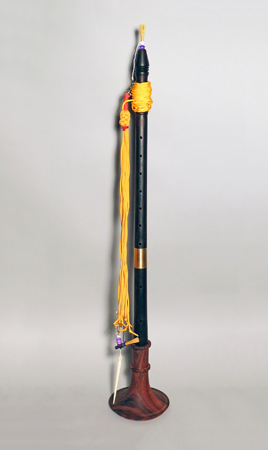
Owner: HWMC
Catalogue #: 2AS-AERV-07
Reedpipes
India 'Nagasvaram' (Bari)
South India
Indian
Wood, cane, metal, ivory, silk, fiber thread
Late 20th century
Length: 36 in; Bell diameter: 6.25 in
Aerophones – Wind Instruments Proper – Reedpipes
The nagasvaram (nagaswaram or nadaswaram), is a conical bore double-reed aerophone of southern India, used in classical Carnatic music and Hindu ceremonial music. There are two varieties of this instrument, the bari nagasvaram seen here, which is the larger of the two, and the timiri, a smaller type, similar to the north Indian shehnai. This nagasvaram is thirty-six inches long, made of a tree called aacha, and has a flaring dark stained wooden bell. The wooden body has seven finger holes and a wide brass band wrapped just below the finger holes and above the five whisper holes called brahma swaram. These holes may be filled with wax to adjust tuning. The double cane reed, called aku (in Telegu), seevali (in Tamil) and peepi (in Kannada) is found on the banks of Kaveri in south India. It is attached to a stylized bocal wrapped with purple thread and a thicker white rope wrapped near the top. There are bright yellow/orange tassels braided and tied to the top. Extra double cane reeds and an ivory needle for reed adjustment are attached at the bottom of the tassels.
In India, the nagasvaram is thought of as a mangala vadya, an auspicious instrument. It is the leading instrument in the periya melam, the South Indian Hindu temple ensemble, and is played with the tavil, a barrel shaped drum also found in this collection. It is played by using a circular breathing technique. The player blows from the cheeks into the reed while drawing air in through the nose simultaneously, so that there is a continuous sound and no interruption for breathing.
